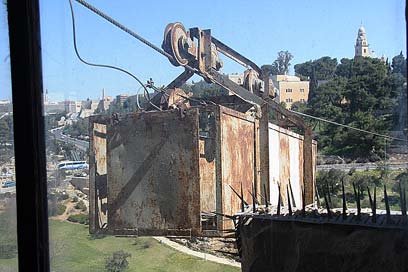
Mount Zion Hotel's military secret
One of Jerusalem's historical and fascinating buildings is wrapped with military stories from the past – starting with the Turks who used it during WWI, and ending with a cable car from the War of Independence, which was kept secret for 24 years. And it all started out as an eye hospital
The building was established in the 1880s, when the Duke of Kent, who was member of the British Order of the Knights of Saint John of Jerusalem, decided together with his colleagues to set up a hospital due to the high number of eye patients in the holy city. Symbols of the Order's knights can still be seen to this day on the building located above the Cinematheque, on Hebron Road.
The building serving as a hotel today was the original main building used by the hospital until World War I. During the war, when the building was hit by heavy bombardments, the Ottoman army used it as a weapons storehouse.
The Brits were the ones who acknowledged the building's special location and decided to renovate it in the 1930s. This task was thrust upon British architect Clifford Holiday, who built the nearby Scottish Church and the historic Jerusalem City Hall.
The building was restored, and two new wings were built: One near the original building, and the second on the other side of the road – where the Jerusalem House of Quality is located these days.
These two buildings had a main road between them (Hebron Road) even then, and a tunnel was dug under the road in order to connect between the two wings. Today the tunnel is closed to visitors. The compound served as a hospital until 1948.
2 minutes in each direction
Today, anyone can tour the hotel compound independently and free of charge. We recommend arriving at the main entrance on Hebron Road. But before entering, ask the guard stationed at the entrance to open the hotel's balcony, located to the right of the entrance, for a few minutes. The view is spectacular – bellow you will see the hotel's swimming pool with the Hinnom Valley stretching out underneath. Right in front of you is Mount Zion, south of the Old City.
Now enter the lobby – from which you can also see the view – and feel the hotel's atmosphere, which takes us back to the 19th century. Go down by foot or using a lift towards the pool, south of which you will spot a villa – which today serves as a small banquet hall, and in the past was the hospital director's home.
Turning a bit to the north, you'll encounter the hotel's active Turkish bathhouse. The jacuzzi bubbling up under the open sky with a view towards Jerusalem's walls is a wonderful thing – but we are not here to discuss the jacuzzi.
If you return to the lobby, you can walk through it into the northern wing, which includes the Cable Car Museum. On your way to the museum, feel free to peek into the hotel rooms, which maintain the place's unique style from the past.
And here is the cable car's story: During the War of Independence there was a problem of accessibility between the western part of the city and Mount Zion. At first the connection was maintained through a tunnel crossing the wadi. Its entrances can be seen today at the entrance to Mishkenot Sha'ananim and going up to Mount Zion, from the traffic light over Sultan's Pool. The tunnel made it possible to transfer supplies to the mountain and evacuate the injured, although in a limited manner.

Solution to communication problem with Mount Zion posts (Photo: Ron Peled)
The solution was formulated by Uriel Hefetz, an engineering corps commander at the Etzioni Brigade, in December 1948. In order for the Jordanian Legion soldiers not to notice a thing, a 200-meter (656-foot) steel cable was stretched over the wadi (Hinnom Valley) every night – from the hospital to a post at the Eretz Hatzvi school on Mount Zion.
The cable car reached a maximal height of about 50 meters (164 feet) above the wadi, and the rail cart could carry a maximal weight of about half a ton. Three soldiers on each side were responsible for operating the cable car, and the ride lasted about two minutes in each direction (a short night flight). At the end of each night, the cable would be taken down. The cable car was kept a military secret for many years, and was only revealed to the public in 1972.
The late Hefetz, as a citizen, helped rescue the injured of the Ma'alot massacre in May 1974, and was seriously injured. He was honored and received a citation from the Israel Defense Forces chief of staff for his activities and contribution to the Israeli army, in addition to the Israel Defense Prize. In recent years Jerusalem commemorated his work with a street called Netiv Harakevel ("the car cable route").
In the Car Cable Museum one can see the authentic rail cart and look at pictures of officers and soldiers who shared the secret, including Moshe Dayan. On a wooden table one can find documents related to the cable care and the top secret.
There are several sites worth a visit near Mount Zion and the Cable Car Museum, including the Menachem Begin Heritage Center and the grave structures in the compound's yard, the St. Andrew's Scottish Church, the Jerusalem House of Quality, The Bnai Brith bridge and Yigal Tumarkin's nearby sculpture, and of course the Mishkenot Sha'anim and Yemin Moshe neighborhoods.















